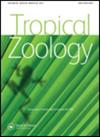啮齿类动物在墨西哥热带橡树林中传播Dion edule苏铁种子
IF 0.4
4区 生物学
Q4 ZOOLOGY
引用次数: 3
摘要
苏铁种子的捕食。索绪尔(Saussure, 1860)的研究表明,如果与多种饮食相结合,这种种子的毒素是无害的。然而,很少有证据表明墨西哥蕨是一种种子传播者。在墨西哥圣路易斯Potosí的热带橡树林中,我们用D. edule和Quercus polymorpha Schltdl的种子进行了实验。&可汗。,评估捕食者的偏好,并用相机记录下来。在不破坏孔洞的情况下,用孔洞镜对孔洞类型和种子状况进行了鉴定。对森林的结构和组成进行了评价。龙葵种子的主要传播途径是弓形虫。啮齿动物以种子为食,对多形沙鼠的偏好高于扁扁沙鼠(存活率分别为48.9%和78.5%)。成熟栎树在3 ~ 6 m处有更多的洞口和多个洞穴。鼠类遗忘或丢弃地穴内的黄花种子,黄花种子在3-6米处萌发。Peromyscus leucopus (Rafinesque, 1818)是菊苣种子的短距离次级传播者和捕食者。本文章由计算机程序翻译,如有差异,请以英文原文为准。
Dispersal of Dioon edule cycad seeds by rodents in a tropical oak forest in Mexico
Predation of seeds of the cycad Dioon edule Lindl. by Peromyscus mexicanus (Saussure, 1860) has been previously documented, demonstrating that the seeds’ toxins are not harmful when combined with a varied diet. However, there is scarce evidence of P. mexicanus as a seed disperser. In a tropical oak forest in San Luis Potosí, Mexico, we experimented with seeds of D. edule and Quercus polymorpha Schltdl. & Cham., evaluating predators’ preference and recording it with photo-trapping. Burrows were sampled in concentric circles around a D. edule mother plant, and the types of burrows and condition of the seeds inside were identified with a borescope without destroying the burrows. The structure and composition of the forest were evaluated. The primary dispersion of D. edule seeds is by barochory. The rodents predate on seeds and prefer Q. polymorpha over D. edule (survival: 48.9% and 78.5%, respectively). There are more escape and multiple burrows at 3–6 m with mature oaks. Rodents forget or abandon D. edule seeds in the burrows, and such seeds germinate at 3–6 m. Peromyscus leucopus (Rafinesque, 1818) is a short-distance secondary disperser and predator of Dioon edule seeds.
求助全文
通过发布文献求助,成功后即可免费获取论文全文。
去求助
来源期刊

Tropical Zoology
生物-动物学
CiteScore
2.50
自引率
0.00%
发文量
1
审稿时长
>12 weeks
期刊介绍:
Tropical Zoology is an international zoological journal publishing original papers in the field of systematics, biogeography, phylogeny, ecology and conservation of all terrestrial and aquatic animal Phyla from tropical and subtropical areas.
Only papers with new information, high quality and broad interest are considered. Single species description and checklists are not normally accepted. Review papers are welcome. The journal is owned by the Istituto di Ricerca sugli Ecosistemi Terrestri of the Consiglio Nazionale delle Ricerche, Florence, Italy (CNR-IRET) who performs research into the structure and functioning of aquatic and terrestrial ecosystems, focusing in particular on anthropogenic pressure and global change. The knowledge amassed forms the scientific basis for identifying the most appropriate protective and corrective interventions, and provides support for the bodies entrusted with formulating policies for environmental protection and recovery.
 求助内容:
求助内容: 应助结果提醒方式:
应助结果提醒方式:


